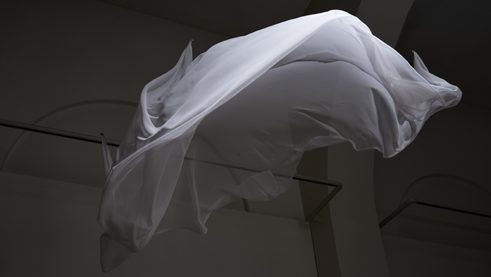Dynamics of Air
Who owns the clouds?

The Goethe-Institut Australia's exhibition "Dynamics of Air" wants to explain air and climate phenomena. The architect and intellectual theoretician Friedrich von Borries explains his fictional project UN-Mahac, which he developed for the exhibition.
The UN-Mahac is a secret institution of the United Nations. It operates mostly on the sly. UN-Mahac stands for ‘United Nations Management and Harvesting of Clouds’. Founded in the 1950s, the institution was supposed to investigate how the weather can be regulated and controlled, on a global scale. While the original idea was to avoid catastrophic droughts, many heads of states may have had less noble objectives, as the manipulation of the weather can also be used as a weapon in times of conflict.
What sounds like a future fantasy, even in an era that is shaped by technological progress, actually matched the scientific research of that time. However, this research was influenced by the UN-Mahac. They supported many scientists with their weather research and initiated large-scale projects. On the one hand, this led to the creation of a substantive cloud atlas: which led to a substantive cloud atlas: areas of development, formation speeds, morphogenesis, and movements where documented, analysed, and mapped.
To rain or not to rain
On the other hand, the UN-Mahac promoted applied research with the help of the American, Soviet, and later Chinese military. Just to name one of the many fields of study: fighter jets were equipped with chemical tanks the dissemination of which could make clouds rain or prevent rain.The experiments of Wilhelm Reich caused the most sensation. Reich, a psychoanalyst and sex researcher, experimented with so-called ‘cloud busters’ that looked like rocket launchers. Those cloud busters were supposed to use the energy of what he called Orgone — a substance discovered by himself — in order to change the weather. According to contemporaneous news articles, his testing led to strong rainfalls, an effect that was confirmed in the early 2000s by German artist and physician, Christoph Keller.
 Edith Kollath's Nothing Will Ever Be The Same
| Photo: Hannes Wiedemann
The practices of the UN-Mahac were not limited to the support of technological developments — they acted on a political scale as well. Central was the question of who owns the clouds — the states where they developed, or those where they were situated. These questions were hard to answer. The residence status of clouds is fluid until they rain out. They are only temporarily present, which is why legal terms of property in the existing international law cannot be applied. At international conferences, legal experts aimed to create a global division of ‘weather zones of influence’ which of course displayed the former power relations.
Edith Kollath's Nothing Will Ever Be The Same
| Photo: Hannes Wiedemann
The practices of the UN-Mahac were not limited to the support of technological developments — they acted on a political scale as well. Central was the question of who owns the clouds — the states where they developed, or those where they were situated. These questions were hard to answer. The residence status of clouds is fluid until they rain out. They are only temporarily present, which is why legal terms of property in the existing international law cannot be applied. At international conferences, legal experts aimed to create a global division of ‘weather zones of influence’ which of course displayed the former power relations.Until today, these ‘weather zones of influence’ are subject to negotiations on UN Climate Change conferences, in which China is of great significance due to the Asian nation’s very active weather manipulation policies, pursued since the 1990s. Within the weather zones of influence, it is the responsibility of the states to implement regulations in accordance to their civil law.
A fair distribution of weather resources?
The airspace above the Antarctic is a highly competitive zone. After long negotiations, it was awarded to the UN-Mahac. Currently, the UN-Mahac is discussing the procedure by which clouds in their areas of responsibility should be distributed. Although the technical questions of cloud harvesting are mostly answered, the key question about distributional issues remains unresolved.Which criteria should be considered: the maximisation of agricultural return, or a fair distribution of weather resources considering equal opportunities — even if that means that crop failure could endanger nutrition all over the world? In addition to the optimisation of weather conditions for global agriculture, another primary objective of the UN-Mahac is to avoid water wars and catastrophic droughts.
The UN-Mahac is arguably the least-known institution, despite the fact that it is one of the most influential UN bodies when it comes to climate change. For a global democracy, it is important to disclose the veil of concealment and make their tasks and activities transparent.
___
Dr Friedrich von Borries is an architect and professor of Design Theory at the Hochschule für Bildende Künste (HFBK) in Hamburg, Germany, operates between the blurring boundaries of urban planning, architecture, design and art. The focus of his work is the relation of design practice and socio-political development.